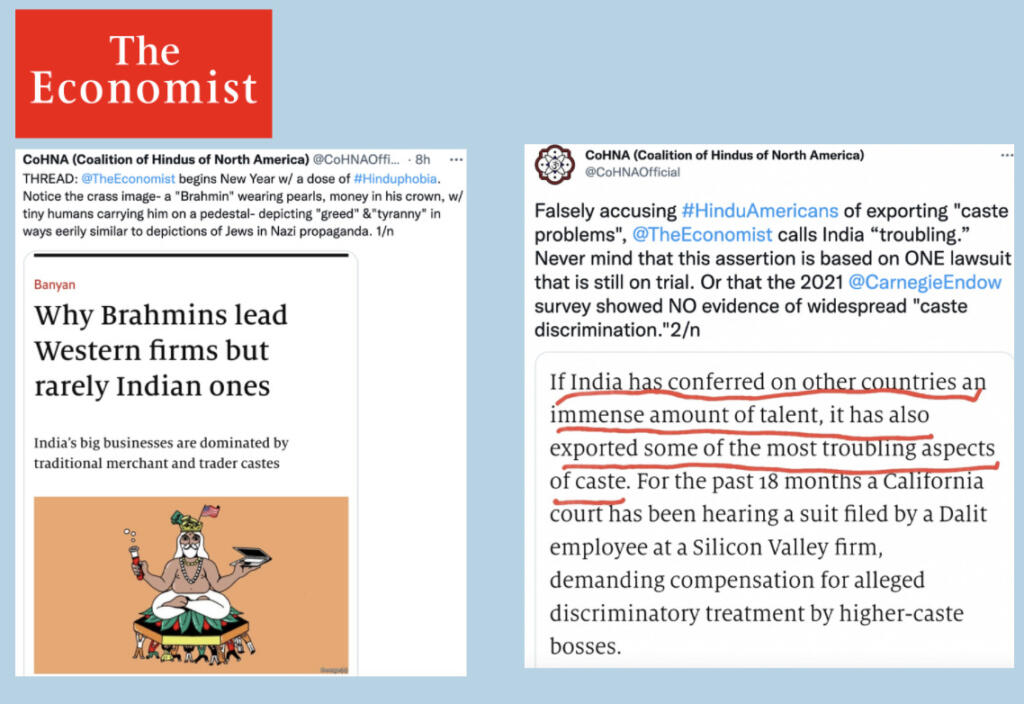Once known as the epitome of credible journalism, The Economist seems to have drifted towards post-modern identity politics. It has started the New Year with a vile attack on Hinduism and Brahmins.
The Economist tries to analyse India’s caste dimensions in foreign companies
On 1st January (2022), a weekly magazine based in London published an India-centered article. The title of the article is “Why Brahmins lead Western firms but rarely Indian ones”. It tries to delve deep into India’s caste dimensions in order to track down the dominance of Brahmins and traders in the intellectual and business space.
The analysis starts with decoding the top positions of the topmost firms in the USA. These seven firms are Adobe, Alphabet, IBM, Match Group, Microsoft, OnlyFans, and Twitter. The author establishes that CEOs of all these firms are of Indian origin. However, the credit for them reaching the top is not accorded to their talent. According to the author, American’s liberalised Visa policy is the main reason behind their success.
Brahmins and Vaishyas are the main targets
The columnist then trudges to find the caste composition of these successful people. 4 of them are Brahmins while the other 3 are Vaishyas. The presence of Brahmins among business meetings seems to be an odd result for the writer.
The columnist believes that Brahmins who excel in bookish knowledge tends to be more successful in academic aspects and not the business. To substantiate his/her point, the columnist cites a few examples. 3 out of 4 noble prizes going to Brahmins and 25 percent of Supreme Court judges coming from Brahmin backgrounds have been put forward as evidence.
At the end of the article, the writer claims that Brahmins succeed in businesses outside India because it is easier for them to gain entry into western countries. It cites India’s reservation policy as the main reason behind their migration.
Brahmin bashing at its best
The author does not seem to enquire about the hurdles being faced by them. He/She simply assumes the fact that just because they are born in a Brahmin family, they are privileged. This is absurd at its face. In fact, Sundar Pichai’s less than humble background is one such example available to the writer.
Traditionally, Brahmins have been dependent on the state and the public for their food. After the freedom of India in 1947, Brahmins have been painted in an extremely bad light. Any attempt by them to climb up the hierarchy is believed to be the manifestation of their privileged (assumed) background; which in itself is called evil.
Similarly, while blaming reservation, the author did not mention how much-unreserved category students have to toil hard to get a seat in IITs. Moreover, the rigorous admission process in the west is another barrier which they cross.
Vaishyas’ success owes more to their background
The write-up also enquires about the dominance of Vaishyas. It mainly focuses on Vaishyas in the top-20 list of India’s billionaires. Tracing the backgrounds of all these billionaires, the author seems to claim that their business background is the main reason for their success.
However, while mentioning Shiv Nadar’s successful journey (in spite of him being from a ‘backward’ class), the columnist claims that his caste had left their traditional family occupation; which proved to be the main reason behind his success.
The Economist takes caste-rivalry in the international arena
The article seems to be an attempt to reinvigorate caste rivalry (introduced by the British) all around the world. Moreover, on the face of it, the article is an attempt to ignite an anti-Brahmin movement. A Twitter user pointed out the similarity between the portrayal of Brahmins in 2022 and the portrayal of Jews as rich oppressors; before their massacre in Hitler’s Germany.
European literature and art similarly caricatured Jews, Roma and other minority groups. A 1937 anti-Semitic art exhibition, called "The Eternal Jew," shows an "eastern" Jew wearing a kaftan, holding gold coins in one hand and a whip in the other. 3/n https://t.co/hwGJvaPzmE pic.twitter.com/lAo5eRgyB2
— CoHNA (Coalition of Hindus of North America) (@CoHNAOfficial) January 2, 2022
The author has based his/her logic around outcome only. He/She just sees the numerical strength and went on to assert their point of view. There is absolutely no mention of merit gained through hard work.
The attack on Hindus is a direct culmination of oppressor/oppressed doctrine run by Neo-Marxists. According to this doctrine, anybody having more than others is assumed to have achieved it through oppressing others below him. These kinds of articles will be used to paint Hindus (especially Brahmins) as oppressors in western academia; in turn, granting traction to Muslims as victims
